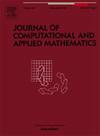Recovery conditions for generalized orthogonal matching pursuit based coherence
IF 2.1
2区 数学
Q1 MATHEMATICS, APPLIED
Journal of Computational and Applied Mathematics
Pub Date : 2025-03-27
DOI:10.1016/j.cam.2025.116648
引用次数: 0
Abstract
In sparse approximation, a key theoretical issue is the guarantee conditions for the exact recovery of -sparse signals. The Orthogonal Matching Pursuit (OMP) and the Generalized Orthogonal Matching Pursuit (GOMP) are two important algorithms commonly used in sparse approximation. The main difference is that the OMP algorithm selects one atom in each iteration, while the GOMP algorithm selects multiple atoms. In the current theoretical analysis, the GOMP algorithm can only guarantee the selection of at least one correct atom in each iteration. However, in practical applications, the GOMP algorithm has been shown to select multiple correct atoms in each iteration but lacks theoretical guarantee conditions. In this paper, we discuss the extended coherence-based conditions for exact support recovery of the -sparse signals using the GOMP algorithm. We propose several sufficient conditions for the GOMP algorithm to select () correct atoms in each iteration in noiseless and bounded-noise cases respectively. Some of the conditions involve the decay of nonzero entries in sparse signals. Numerical experiments demonstrate the effectiveness of the proposed sufficient conditions.
基于广义正交匹配追踪的相干恢复条件
在稀疏逼近中,一个关键的理论问题是s-稀疏信号精确恢复的保证条件。正交匹配追踪(OMP)和广义正交匹配追踪(GOMP)是稀疏逼近中常用的两种重要算法。主要区别在于OMP算法在每次迭代中选择一个原子,而GOMP算法在每次迭代中选择多个原子。在目前的理论分析中,GOMP算法在每次迭代中只能保证至少选择一个正确的原子。然而,在实际应用中,GOMP算法在每次迭代中选择了多个正确的原子,但缺乏理论保证条件。本文讨论了利用GOMP算法精确支持恢复s-稀疏信号的扩展相干条件。我们提出了GOMP算法在无噪声和有界噪声情况下每次迭代分别选择M(1≤M≤s)个正确原子的几个充分条件。一些条件涉及到稀疏信号中非零项的衰减。数值实验验证了所提充分条件的有效性。
本文章由计算机程序翻译,如有差异,请以英文原文为准。
求助全文
约1分钟内获得全文
求助全文
来源期刊
CiteScore
5.40
自引率
4.20%
发文量
437
审稿时长
3.0 months
期刊介绍:
The Journal of Computational and Applied Mathematics publishes original papers of high scientific value in all areas of computational and applied mathematics. The main interest of the Journal is in papers that describe and analyze new computational techniques for solving scientific or engineering problems. Also the improved analysis, including the effectiveness and applicability, of existing methods and algorithms is of importance. The computational efficiency (e.g. the convergence, stability, accuracy, ...) should be proved and illustrated by nontrivial numerical examples. Papers describing only variants of existing methods, without adding significant new computational properties are not of interest.
The audience consists of: applied mathematicians, numerical analysts, computational scientists and engineers.

 求助内容:
求助内容: 应助结果提醒方式:
应助结果提醒方式:


